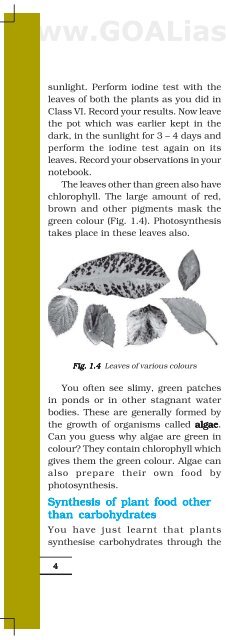com www.GOALias.blogspot.com www.GOALias ... - fun learning
com www.GOALias.blogspot.com www.GOALias ... - fun learning
com www.GOALias.blogspot.com www.GOALias ... - fun learning
- No tags were found...
Create successful ePaper yourself
Turn your PDF publications into a flip-book with our unique Google optimized e-Paper software.
<strong>www</strong>.<strong>GOALias</strong>.<strong>blogspot</strong>.<strong>com</strong>sunlight. Perform iodine test with theleaves of both the plants as you did inClass VI. Record your results. Now leavethe pot which was earlier kept in thedark, in the sunlight for 3 – 4 days andperform the iodine test again on itsleaves. Record your observations in yournotebook.The leaves other than green also havechlorophyll. The large amount of red,brown and other pigments mask thegreen colour (Fig. 1.4). Photosynthesistakes place in these leaves also.Fig. 1.4 Leaves of various coloursYou often see slimy, green patchesin ponds or in other stagnant waterbodies. These are generally formed bythe growth of organisms called algae.Can you guess why algae are green incolour? They contain chlorophyll whichgives them the green colour. Algae canalso prepare their own food byphotosynthesis.Synthesis of plant food otherthan carbohydratesYou have just learnt that plantssynthesise carbohydrates through theprocess of photosynthesis. Thecarbohydrates are made of carbon,hydrogen and oxygen. These are usedto synthesise other <strong>com</strong>ponents of food.But proteins are nitrogenous substanceswhich contain nitrogen. From where dothe plants obtain nitrogen?Recall that nitrogen is present inabundance in gaseous form in the air.However, plants cannot absorb nitrogenin this form. Soil has certain bacteriathat convert gaseous nitrogen into ausable form and release it into the soil.These soluble forms are absorbed by theplants along with water. Also, you mighthave seen farmers adding fertilisers richin nitrogen to the soil. In this way theplants fulfil their requirements ofnitrogen along with the otherconstituents. Plants can thensynthesise <strong>com</strong>ponents of food otherthan carbohydrates such as proteinsand fats.1.3 OTHERMODESOF NUTRITIONINPLANTSThere are some plants which do not havechlorophyll. They cannot synthesisetheir food. How do they survive and fromwhere do they derive nutrition? Likehumans and animals such plantsdepend on the food produced by otherplants. They use the heterotrophicmode of nutrition. Look at Fig. 1.5. Doyou see yellow tubular structurestwining around the stem and branchesof a tree? This is a plant called Cuscuta(Amarbel). It does not have chlorophyll.It takes readymade food from the plant4SCIENCE
















